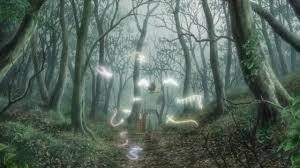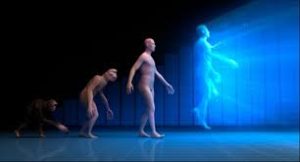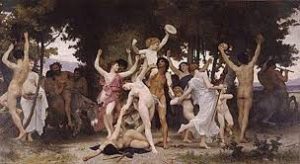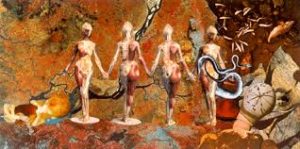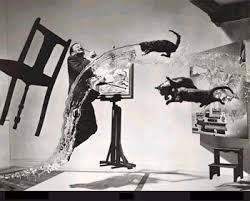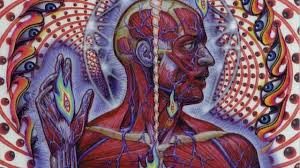But its complexity, its order and magnificence of structure and design should be understood as composing but one example of the infinite number of realities, each constructed by the propensities and characteristics of its own nature and the nature of its own consciousness.
The word “unconscious” is in a fashion meaningless. There are endless versions of consciousness, of course, with their own worlds, forming organizations of meaning and purpose. Some of these mingle with our own and vise versa. The “inner structure” is one of consciousness, and the deepest questions can eventually only be approached by granting the existence of inner references.
The nature of time, questions concerning the beginning or ending of the universe — these cannot be approached with any certainty by studying life’s exterior conditions, for the physical references themselves are merely the manifestations of inner psychological activity. We are aware of the universe only insofar as it impinges upon our perception. What lies outsides of that perception remains unknown to us. It seems to us, then, that the world began — or must have begun — at some point in the past, but that is like supposing that one piece of a cake is the whole cake , which was baked in one oven and consumed perhaps in an afternoon.
The inner references of reality involve a different kind of experience entirely, with organizational patterns that mix and merge at every conceivable point. We tune our consciousness while we sleep as one might tune a piano, so that in waking reality, it clearly perceives the proper notes and values that build up into physical experience. Those inner fields of reference in which we have our existence are completely changing themselves as our experience is added to them, and our own identity was couched in those references before birth as we understand it.
We are one conscious version of oneself, creating along with all of our contemporaries the realities of the times. When I use the term “contemporaries,” I refer to all of the species. We read our consciousness in certain fashions, but it is quite possible to read the consciousness of the world in other ways also.
Scientists do not know how many species exist on earth — only that they total in the billions. If we read it sideways, so to speak, we would still end up with an orderly universe, but one in which the nature of identity would read completely differently, stressing adjacent subjective communications of a conscious kind that form other kinds or patterns of subjectivity and psychological continuity. These result in the formation of “personalities” or entities who are aware of their own identities by following different pathways than our own, while also in their way contributing to the formation of our universe even as we do.
Our numbering of the species is highly capricious. Again, we recognize as alive only those varieties or life that fall within certain ranges of attention. We objectify and diversify. The lines drawn between the self and what is non-self, between an organism and its environment, are highly arbitrary on our part. There are psychological patterns, therefore, that completely escape our notice because they do not follow the conventions that we have established. These combine what we diversify, so that we have hidden psychological values or psychological beings that combine the properties of the environment and the properties of selfhood in other combinations than those we know.
They would seem to be the spirits of nature, as we would be more or less bound to interpret them from our viewpoint. They would certainly be psychological relatives, but with their own time schemes, languages, and psychological affiliations. These do exist along with the kinds of consciousness that we recognize within the structure of physical life. When we dream, however, we often come in contact with these cousins of consciousness. It is not simply that they communicate with us, or we with them, so much as it is that in sleep the conventional properties that we have learned are somewhat loosened and abandoned. We see “the lights around the corner,” so to speak. We see a species of consciousness, a species that remain unexplained in any normal explanations of evolution, and these hint at the communications that exist as all levels, protecting not only the genetic references necessary to our own kind , but the combinations of other forms of organization that exist adjacent to our own, yet connected to them. We have often misread such references, and many of our legends of good and evil spirits, monsters and strange varieties of artificial creatures, appear in folklore.
At one time, however, we encountered such other formations in a different light, or course, seeing many similarities between their behavior and ours — certain characteristic ways of perceiving at least some experience that elicited our response and recognition.
At one time, then, we were more open in a fashion to the kinds of consciousness that we admitted into our circle of reality. At one time, in those terms, we did not draw the lines as finely as we do now. Instead we included such cousins of consciousness into our midst, accepting a kind of comradeship– for to some extent at least we could see the different versions of humanity that resulted from a change of focus, an adjacent affiliation of humanized energy with the environment. Quite simply, we felt that in certain terms we had other brothers and sisters in the world that were like us but unlike us, that put together the contents of the universe in their own fashions. Such species, of course, can nowhere appear within the dictates of evolution or be perceived as realities except under those conditions when we relax our usual conventions of perception and behavior.
Nevertheless, encounters between us occur frequently — in the dream state as stated, in alterations of our usual focus, and in our arts, where we are less arbitrary in our definitions. As we began to bring our own physical reality into harder, clearer focus, we stopped with our own view of human consciousness, shutting off completely and rather arbitrarily those other elements in order to more clearly frame and define the boundaries of physical order. It seems to us now that such personalities are not physically perceivable, but at one time we could bring them into the range of our perception.
We ended our classifications where we did, however, preferring to see human as the king of intelligence. This meant that we abruptly drew the line where it now seems it must have been drawn. We continued that companionship, however, at other levels of activity, levels that are still open and that must be taken into consideration whenever we approach any discussion of dreaming and the dreaming world.
I have not for good reason touched upon certain material because I felt my blog readers were not ready for it.
As my blog reader’s abilities grow, however, of course you will sense the outlines of other realities, the glimmerings of other worlds. You will sense these cousins of consciousness in one way or another — these environments that seem real but not real, these further extensions of possible experience — and some may decide that one must be very cautious: One must be prudent, one must take his or her time, he /she must range but carefully — and certainly to some extent such feelings cut down upon his or her spontaneity.
The cautions are natural enough under the restrictions man and woman usually places upon consciousness. One can carry his or her protection and safety wherever he or she goes. It is a natural grace, characteristic of consciousness of any kind. Its protection and validity are always honored. You are safe wherever one goes. His or her psychological stance is honored wherever he or she goes.
I will have more to say on this subject in my next blog. These few statements. however, will help him or her and help him/her enlarge on an inner circle of acquaintanceship with friendly colleagues that belong in those other categories, but indeed are friendly colleagues as well.
Dreams: Something in me / ebbs and tides, / as if I let myself / for a while / be washed away / out to sea / while leaving / some spidery shell / upon the shore.





